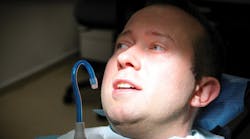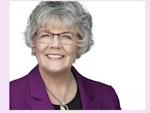On stage with evacuation lines: Safety guidance for dental hygienists
Patti DiGangi, BS, RDH
“As a child with a very active imagination, I spent hours in my make-believe world. I hung with a posse of fellow actors of all ages. As fourth graders we spent weeks writing and rehearsing plays. Of course, our parents raved about our talent and the stars we were destined to become. Then reality struck! I could become an actress, but my father forced me to get a career as a safety net. When asked, ‘What do you want to do?’ my answer was dental hygienist because I loved my sister’s treatment room. The round porcelain tray and swirling water in the little spit sink was so cool!”
—Excerpt from DentalCodeology: Don’t Improve—Improv
with Liz Nies and Patti DiGangi
That little white porcelain spit sink with swirling water is truly ancient, though cuspidors still exist and are used. When the majority of practices moved from patient expectoration to suction, we traded one risk for another. Vacuum system cross-contamination, or “suck-back,” has been proven. Patients are getting the backwash from other patients. This is dangerous and downright gross. Daily cleaning, deodorizing, and maintaining evacuation lines is imperative.
As dental hygienists, we are on stage each day for our patients. It is our responsibility to give our best performance—and this includes infection control. Let’s take a look at how we can create a safe environment for our patients and end suck-back.
© Zoran Milisavljevic - Dreamstime.com
Backflow with saliva ejectors
It’s been 25 years since the Watson and Whitehouse article “Possibility of cross-contamination between dental patients by means of the saliva ejector” was published in 1993 in the Journal of the American Dental Association. Yet as recently as a week ago, an RDH friend shared how grossed out she was when asked by another RDH to “put your lips around the suction tip.”
This research showed, and it has been subsequently demonstrated over and over, that backflow from saliva ejectors using red dye became deposited in patients’ mouths when patients closed their lips around the saliva ejectors.1 Though antiretraction valves have been available for a long time, they are still not used universally.
As of 2016, the Centers for Disease Control and Prevention says that based on current science, backflow occurs when previously suctioned fluids that are present in the suction tubing flow back into the patient’s mouth. This happens under the following conditions:
• There is pressure in a patient’s mouth (a result of closing his/her lips and forming a seal around the tip of the ejector) that is less than in the saliva ejector (similar to how liquid flows back into a cup after drinking through a straw).
• The suction tubing attached to the ejector is positioned above the patient’s mouth.
• A saliva ejector is used at the same time as other evacuation (high-volume) equipment.2
Maintaining evacuation lines
Failure to clean evacuation lines daily leads to biofilm growth, a heavy bioburden, and a greater risk of transmission. When debris clogs evacuation lines, not only does this create risk, they don’t suck! If the vacuum system isn’t cleaned regularly/daily, thick deposits will form, which can block or minimize performance. It is critical to proper functioning to clean and maintain the system. Daily cleaning protects the investment in equipment and maintains full suction power.
EPA best practices
Checking with the manufacturer of the evacuation system to verify which disinfectants are compatible with the system is necessary. The evacuation line cleaner selected should meet the specifications of the amalgam separator manufacturer, be easy to use, have a pleasant odor, and have low toxicity.
Many of the evacuation system cleaners have enzymes that facilitate cleaning of debris from the tubing. Sometimes, in a desire to save money, a practice will choose to use inexpensive chlorine bleach or other corrosive products.
The Environmental Protection Agency issued its final rule specific to Best Management Practices for Dental Amalgam Waste on June 14, 2017.3 The final rule prohibits the use of bleach or chlorine-containing cleaners that may lead to the dissolution of solid mercury when cleaning chairside traps and vacuum lines. The final rule states the following: “ . . . vacuum lines that discharge amalgam process wastewater to a POTW [publicly owned treatment works] must not be cleaned with oxidizing or acidic cleaners, including but not limited to bleach, chlorine, iodine, and peroxide that have a pH lower than 6 or greater than 8.”3
When looking for an appropriate cleaning product, there are many features to consider. A good example to consider is a product from Air Techniques. The company is a manufacturer of dental vacuum systems, and its Monarch CleanStream is an advanced vacuum system cleaner. The product complies with the EPA final rule, having a pH of 7 to 8 (diluted) and not containing any oxidizing agents. It keeps vacuum lines free of buildup, cleans and deodorizes lines, and is compatible with all amalgam separators.
Acting prevention
We as dental hygienists are on stage all day, performing eight-plus times. Like the simplest play, our work needs a beginning, middle, and end. Take these steps and help keep your patients safe:
• Prepare your treatment room with best infection prevention.
• After each appointment, flush waterlines to prepare for the next patient.
• Finally, at the end of the day, flush evacuation lines with a cleaner to help reduce debris and the number of microorganisms.
Editor’s note:An earlier version of this article appeared on DentistryIQ in October 2018.
References
1. Watson CM, Whitehouse RL. Possibility of cross-contamination between dental patients by means of the saliva ejector. J Am Dent Assoc. 1993;124(4):77-80.
2. Saliva ejector & backflow. Centers for Disease Control and Prevention website. https://www.cdc.gov/oralhealth/infectioncontrol/questions/saliva.html. Updated March 3, 2016.
3. Effluent limitations guidelines and standards for the dental category. Federal Register website. https://www.federalregister.gov/documents/2017/06/14/2017-12338/effluent-limitations-guidelines-and-standards-for-the-dental-category. Published June 14, 2017. Updated July 5, 2017.
Editor's note: Looking for information about infection control related to the coronavirus pandemic? Please visit our COVID-19 channel for the most up-to-date information for dental health-care professionals.
Patti DiGangi, BS, RDH, is an international speaker who is passionate about prevention and working with dental professionals to improve practice profitability. Patti is the author of the DentalCodeology book series for busy dental professionals. She recently published DentalCodeology: Critical Decisions Workbook: Teledentistry Pathway to Prosperity, coauthored by Cindy Purdy, RDH. Patti also holds publishing and speaking licenses with the American Dental Association for CDT and SNODENT.








